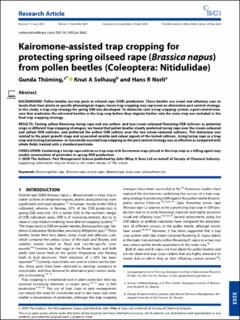Kairomone-assisted trap cropping for protecting spring oilseed rape (Brassica napus) from pollen beetles (Coleoptera: Nitidulidae)
Peer reviewed, Journal article
Published version
Permanent lenke
https://hdl.handle.net/11250/2827097Utgivelsesdato
2020Metadata
Vis full innførselSamlinger
Sammendrag
BACKGROUND Pollen beetles are key pests in oilseed rape (OSR) production. These beetles use visual and olfactory cues to locate their host plants at specific phenological stages, hence trap cropping may represent an alternative pest control strategy. In this study, a trap crop strategy for spring OSR was developed. To elaborate such a trap cropping system, a pest control measure that eradicates the attracted beetles in the trap crop before they migrate further into the main crop was included in the final trap cropping strategy. RESULTS Testing yellow‐flowering turnip rape and one yellow‐ and two cream‐coloured flowering OSR cultivars as potential crops in different trap cropping strategies, we found that pollen beetles clearly preferred turnip rape over the cream‐coloured and yellow OSR cultivars, and preferred the yellow OSR cultivar over the two cream‐coloured cultivars. This behaviour was related to the plant growth stage and associated volatile and colour signals of the tested cultivars. Using turnip rape as a trap crop and testing kairomone‐ or insecticide‐assisted trap cropping as the pest control strategy was as effective as compared with whole fields treated with a standard pesticide. CONCLUSION Combining a turnip rape cultivar as trap crop with kairomone traps placed in the trap crop as a killing agent may enable renunciation of pesticides in spring OSR production. © 2020 Society of Chemical Industry
